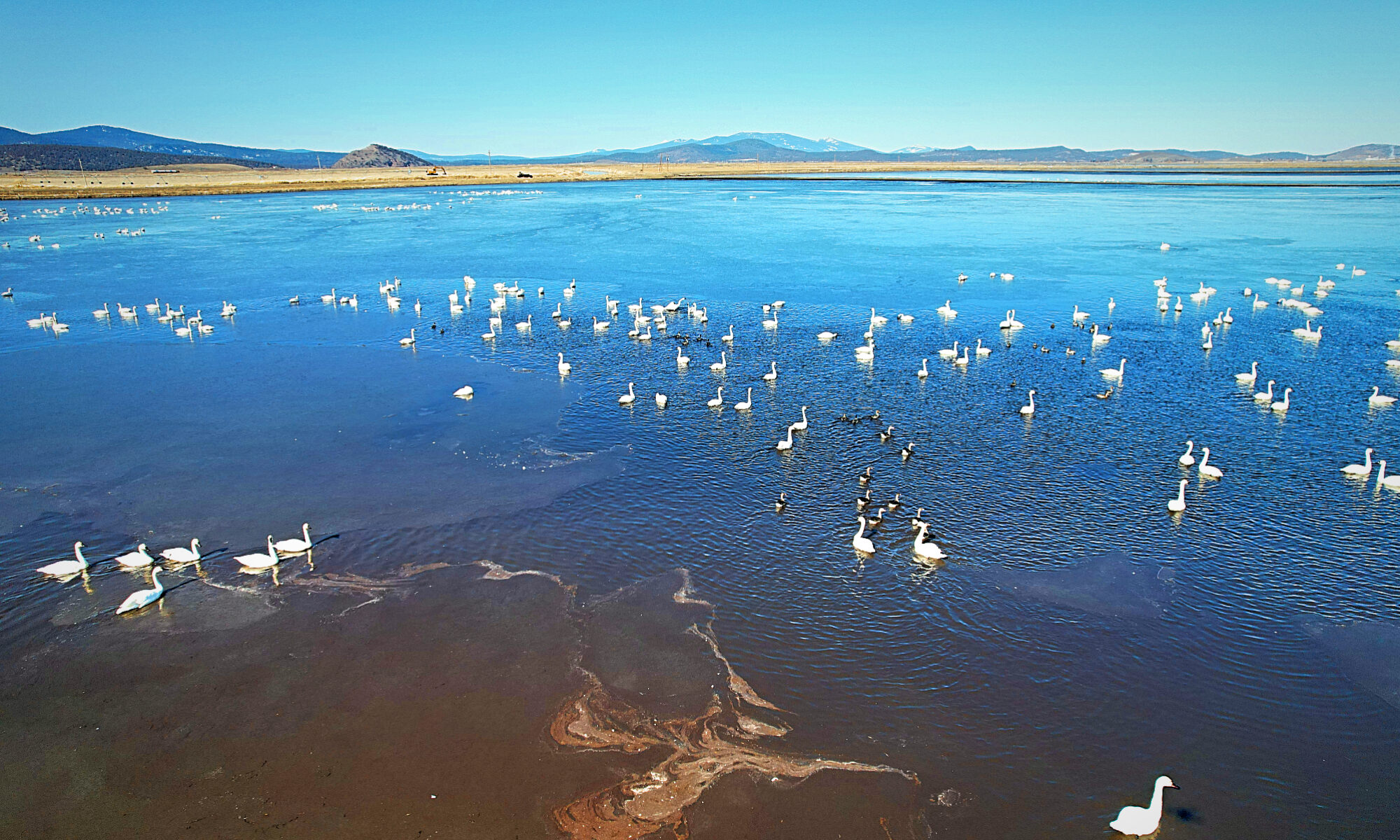(Note: This article was written by the Klamath Drainage District’s PR administrator on behalf of the Lower Klamath Renaissance Tour. This article also appears on Basin Ag News and on the Klamath Water Users Association’s website.)
News of the 2024 Winter Wings Festival cancellation spread through the Klamath Basin like the wind over the barren lakebed of the Lower Klamath National National Wildlife Refuge.

Known as in the Klamath Basin winter for decades. The workshops brought birders and tourists to our community, while the chance to see a variety of raptors and birds migrating on the Pacific Flyway drew in photographers from all over the world. In recent years, Winter Wings also gave Klamath ag a chance to share how farms provide much needed habitat for area wildlife and the Pacific Flyway, especially with the historic dewatering of two national wildlife refuges.
the nation’s oldest birding festival, Winter Wings provided a bright spot
When word passed through the birdwatching, conservation, and agricultural circles the Winter Wings Festival was canceled, phones started ringing. A conversation regarding the impacts of canceling the Winter Wings Festival between Klamath Drainage District manager, Scott White, and Board Chair of the South Suburban Sanitary District (SSSD), Joe Spendolini, ended the call with the two agreeing for the organizations to arrange a tour similar to one White had organized for the festival in previous years.
In a matter of weeks, White pulled together a team that included the Modoc Nation, South Suburban Sanitary District, Ducks Unlimited, Friends of Klamath Basin Birding, the Klamath Basin Audubon Society, and the Klamath Water Users Association to create what would become the Lower Klamath Renaissance Tour.
The Lower Klamath Renaissance Tour team’s goal was to highlight the importance of the Lower Klamath National Wildlife Refuge (LKNWR) to the Basin and the collaboration needed to create water security for the nation’s first waterfowl refuge. Invitations were sent to guests at federal agencies, conservation organizations, local leaders, and Klamath Basin Tribes. On March 7th, the week’s expeditiously organized tour left the Running Y Resort to see and discuss what could happen.

From the Klamath Drainage District’s F/FF pumping station through the district, down to where the Ady Canal meets Stateline and on to Lower Klamath National Wildlife Refuge, the tour centered on projects and plans that KDD, Ducks Unlimited, the US Fish and Wildlife Service, and the Modoc Nation were working on to help improve conditions on the refuge and increase its access to water.
The discussions about the history of Lower Klamath Lake, the people who lived there from time immemorial, the formation of the Klamath Irrigation Project, the creation of KDD and LKNWR, and the projects provided context for the conversations that would take place throughout the day.
A lot of those conversations, both between individuals and in the larger groups, focused on collaboration. There was a quiet acknowledgement that everyone was tied together, and regardless if the guests were there on behalf of farmers, fish, waterfowl, or clean water, no one would be able to succeed in their goal without the other partners succeeding in theirs.

“Today provided lines of communication to open up once again. It was a safe space for interested parties to speak, share ideas and share our struggles,” wrote Normajean Cummings, enrolled member of the Klamath Tribes. “It was also an opportunity to see some changes Agriculture is doing to make a difference. Learning more about the difference wetlands can make is eye awakening.”
Ms. Cummings added, “I’m afraid that drought is the new normal, and I think all our communities need to be able to come together to collaborate and find new practices. We have seen what hasn’t worked in the past, but there are some new models out there that bring me hope. I hope to remain involved in seeking solutions and community building. I also hope for more opportunities like today where we can all gather, talk, offer thoughts and ideas and find a path forward that will benefit us all. Opportunities to learn from one another.”
Karuk Tribe Council Member Troy Hockaday’s takeaway of the discussions, “Today was amazing to hear from the farmers and the government and the fisheries people about the problems in the basin. I came out of the day that we all have the same mindset to make the Basin better for everybody and a quality of water for the fish and habitat, I hope some of discussions that we talked about will help with further future programs and projects in the basin, to help water control for the Klamath river base.”

“Five to six years ago, we couldn’t get a meeting with anyone from the Tribes, and today we had folks from the Modoc Nation, Karuk, and the Klamath Tribes come to this meeting,” said Bill Walker, board president of the Klamath Drainage District. “I feel strongly that we can fix the problems we’re all facing because we’re all working together. I can’t thank everyone enough for coming and getting the doors open. We need to get together again and keep this momentum moving.”
The day was successful from the point of view of bringing together partners from a variety of backgrounds, interests, and needs, and to get them talking. However, the Lower Klamath Renaissance Tour serves as a starting point for bringing water security to the Lower Klamath refuge and other initiatives for the Klamath Basin. Whether it’s KDD’s Replumbing the Klamath plan, SSSD’s wastewater treatment facility to provide water to the refuge, Ducks Unlimited’s highline canal and pumping station for LKNWR, or the Modoc Nation and Modoc National Forest’s Shapa’sh Landscape Restoration Project, more hard conversations and collaboration will be needed.
And hopefully, the spirit of collaboration we saw on March 7th will continue to push the momentum forward on these projects and more for the future of all creatures that are dependent on the Klamath watershed.



